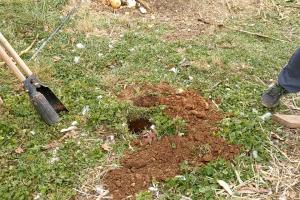Essential Guide: How to Dig Post Holes Effortlessly

-
Quick Links:
- Introduction
- Tools Required for Digging Post Holes
- Preparation Before Digging
- Effective Digging Techniques
- Determining Post Hole Depth
- Case Studies
- Expert Insights
- Step-by-Step Guide
- Common Mistakes to Avoid
- FAQs
Introduction
Digging post holes is an essential skill for homeowners and DIY enthusiasts alike. Whether you’re installing a fence, setting up a mailbox, or creating a garden trellis, understanding how to dig post holes properly can save you time and effort. In this comprehensive guide, we will dive deep into the techniques, tools, and best practices for digging post holes efficiently.
Tools Required for Digging Post Holes
Before beginning your project, having the right tools is crucial. Here’s a list of essential tools:
- Post Hole Digger: This is a specialized tool designed for digging narrow holes.
- Auger: A manual or powered auger can make the job easier, especially in tough soil.
- Shovel: A flat shovel helps remove loose soil and debris.
- Digging Bar: Use this to break up hard soil or rocks.
- Measuring Tape: For measuring depth and spacing.
- Level: To ensure your posts are straight.
- Safety Gear: Gloves, goggles, and sturdy footwear for protection.
Preparation Before Digging
Preparation is key to successful post hole digging. Here are the steps you need to follow:
- Location Selection: Choose the right spot for your posts, ensuring it’s free from underground utilities.
- Check Local Regulations: Some areas have specific codes regarding post installations, especially for fences.
- Mark the Area: Use stakes and string to outline where each post will go.
- Check Soil Condition: Wet or overly dry soil can affect the ease of digging.
Effective Digging Techniques
Mastering the right techniques can make digging post holes easier. Here are some effective methods:
Using a Post Hole Digger
To use a post hole digger:
- Insert the blades into the ground and open the handles to scoop up soil.
- Lift the digger out of the hole and release the soil.
- Repeat until you reach the desired depth.
Using an Auger
If you opt for an auger:
- Position the auger over the marked spot.
- Turn the auger clockwise to dig into the soil.
- Pull out the auger occasionally to remove soil buildup.
Determining Post Hole Depth
Determining the correct depth for your post holes is essential for stability:
- Generally, the depth should be one-third of the total post length.
- In regions with frost, deeper holes may be necessary to prevent shifting.
Case Studies
Understanding real-world applications can enhance your approach to digging post holes. Here are two case studies:
Case Study 1: Residential Fence Installation
A homeowner in a suburban area needed to install a wooden fence. By researching local building codes and using a post hole auger, they completed the project efficiently, ensuring each post was stable and compliant with regulations.
Case Study 2: Garden Trellis Setup
A gardening enthusiast used a manual post hole digger to install a trellis for climbing plants. By carefully measuring the depth and spacing, they achieved a sturdy setup that enhanced their garden's aesthetic.
Expert Insights
We reached out to landscaping professionals for their top tips when digging post holes:
"Always check the soil moisture before digging. Wet soil can collapse, while dry soil can be very hard to penetrate." - Jane Doe, Landscape Architect.
Step-by-Step Guide
Follow these steps to dig post holes like a pro:
- Gather all your tools and safety gear.
- Mark out the holes using stakes and a string line.
- Check the soil condition and moisture.
- Start digging using your chosen tool, maintaining the correct depth.
- Remove any rocks or debris as you dig.
- Use a level to check that the hole is straight.
- Once done, clean the hole and prepare for the post installation.
Common Mistakes to Avoid
Even seasoned DIYers can make mistakes. Here are common pitfalls to avoid:
- Not checking for underground utilities.
- Digging holes that are too shallow.
- Failing to account for soil type.
- Neglecting to use a level for post alignment.
FAQs
1. How deep should I dig post holes?
The depth should generally be one-third of the post length, or deeper in frost-prone areas.
2. What type of soil is hardest to dig?
Clay soil is typically the hardest to dig due to its density and compactness.
3. Can I dig post holes in the rain?
It's best to avoid digging in the rain as wet soil can collapse and make the job messier.
4. How do I find underground utilities?
Contact local utility companies or use a utility locator service before digging.
5. Is there a tool that makes digging easier?
An auger can significantly reduce the effort required to dig post holes, especially in rocky soil.
6. How do I know if my post hole is deep enough?
Use a measuring tape to ensure the depth is consistent with your project requirements.
7. What is the best time of year to dig post holes?
Spring and fall are generally ideal due to moderate weather conditions.
8. Do I need to compact the soil after placing the post?
Yes, compacting the soil around the post helps secure it in place.
9. Can I use a shovel instead of a post hole digger?
While possible, a post hole digger is more efficient for narrow, deep holes.
10. What should I do with excess soil?
Excess soil can be used to fill in low spots in your yard or as mulch in garden beds.
Conclusion
Digging post holes doesn’t have to be a daunting task. With the right tools, techniques, and preparation, you can accomplish this project with ease. Remember to follow local regulations and consider soil conditions for the best outcome. Happy digging!